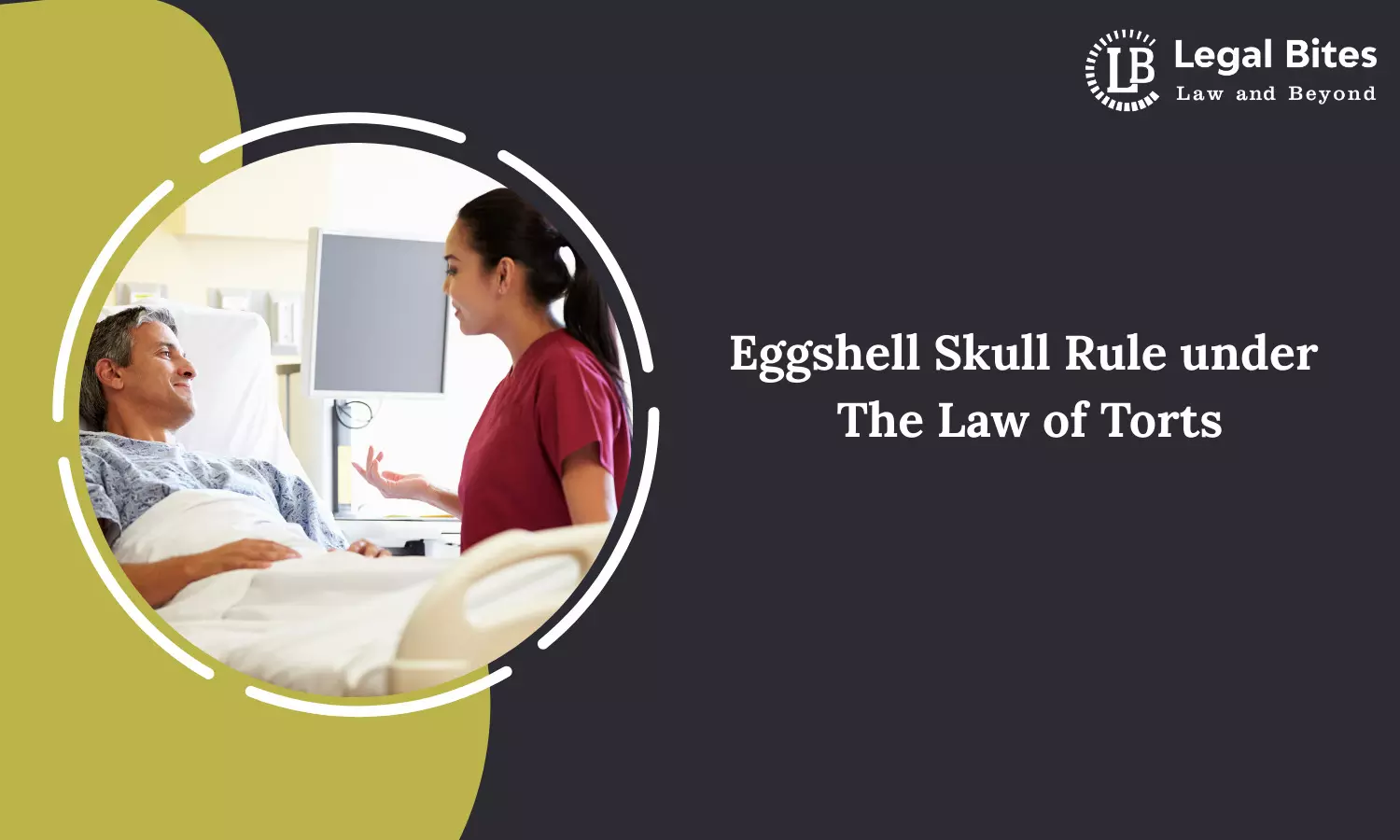Eggshell Skull Rule under the Law of Torts
The Eggshell Skull Rule holds defendants fully liable for harm caused, even if the plaintiff's injury is worsened by a pre-existing condition.

The Eggshell Skull Rule, also known as the Thin Skull Rule, is a foundational principle in the law of torts that holds a defendant liable for the full extent of a plaintiff’s injuries, even if the injuries are unexpectedly severe due to a pre-existing condition or special vulnerability of the plaintiff. This doctrine enshrines the idea that a tortfeasor “takes the victim as he finds him,” ensuring justice even when the harm surpasses foreseeable limits.
The rule plays a crucial role in personal injury law by protecting vulnerable individuals and deterring negligent behaviour. This article delves into the origin, rationale, scope, judicial interpretation, limitations, and criticisms of the Eggshell Skull Rule.
Origin and Development of the Rule
The Eggshell Skull Rule has its origins in English common law, particularly in Smith v. Leech Brain & Co. Ltd. [(1962) 2 QB 405], where the court upheld the defendant’s liability for a plaintiff’s fatal cancer, triggered by a burn at work due to negligence. Though the cancer was pre-existing and unknown, the court ruled that since the initial injury was foreseeable, the extent of the damage was irrelevant.
The term “eggshell skull” comes from the idea that even if a person has an unusually fragile skull (like an eggshell), the defendant is still liable for causing a severe head injury, even if a normal person would have suffered only a minor injury.
Principle of ‘Take Your Victim as You Find Him’
The essence of this rule is reflected in the Latin maxim “Talem qualem”, meaning the tortfeasor takes the victim as he finds him. It applies to all tort actions involving personal injury, including negligence, battery, and assault. The courts have repeatedly emphasised that the rule is meant to avoid injustice to the claimant and not allow wrongdoers to benefit from the victim’s frailty.
Key Principles of the Rule
- Complete Accountability Despite Prior Conditions: A defendant remains fully accountable for all injuries inflicted, even if the harm is intensified due to the victim's existing physical or psychological vulnerabilities.
- Compensation Not Subject to Reduction: The presence of a pre-existing condition does not justify lowering the compensation awarded; the victim is entitled to full damages regardless of their heightened susceptibility.
Scope and Application of the Rule
1. Personal Injury and Negligence
The Eggshell Skull Rule most commonly appears in negligence cases involving physical harm. For instance, if a person with a pre-existing medical condition like haemophilia sustains a severe injury from a minor accident, the defendant is still fully responsible.
Example: A slight push causes a person with osteoporosis to fracture a bone. The liability remains with the defendant even if the injury would not have occurred in a healthy person.
2. Psychological Harm
The rule has also been extended to mental or psychological injuries. Courts have held that if a negligent act triggers a psychiatric illness in someone predisposed to such conditions, the defendant remains liable.
In Page v. Smith (1995) — The House of Lords held that if personal injury was foreseeable, the defendant is liable for psychiatric damage even if the plaintiff had a predisposition.
3. Criminal Law Overlap
Though primarily a civil doctrine, the principle has also influenced criminal cases. For example, in homicide cases, the fact that the victim was especially vulnerable is not a defense to reduce the charge.
In R v. Blaue (1975), the defendant stabbed a woman who was a Jehovah’s Witness and refused a life-saving blood transfusion. The court held the refusal was irrelevant; the defendant was liable for her death.
Exceptions and Limitations
While the rule is stringent, courts may consider the following while adjudicating:
1. No Causal Link
If the injury is not causally connected to the defendant’s act, the Eggshell Skull Rule will not apply. The injury must be a direct consequence.
2. Intervening Acts
If a new, independent act intervenes between the defendant’s action and the injury, the chain of causation may be broken.
3. Consent or Assumption of Risk
In certain cases, if the plaintiff knowingly exposes themselves to risk, the compensation might be adjusted, though this rarely negates the rule fully.
Criticism of the Rule
Despite its moral appeal, some scholars argue that:
- It may impose unfair burdens on defendants,
- It leads to disproportionate liability, especially in cases of minor fault,
- Insurance premiums may increase due to increased unpredictability in tort claims.
However, most legal systems uphold the rule as necessary to balance equity in personal injury claims.
Relevance in Today’s Legal System
With rising awareness of mental health, genetic disorders, and chronic illnesses, the Eggshell Skull Rule becomes even more significant. It ensures that justice is not limited to the "average" person but applies equitably across all individuals, regardless of their physical or mental constitution.
In India, with increasing cases of road accidents, medical negligence, and workplace injuries, the doctrine serves as a tool to ensure that victims are not left uncompensated due to their vulnerabilities.
Conclusion
The Eggshell Skull Rule remains one of the most compelling doctrines under tort law. It upholds the fundamental principle that liability follows the act, not the condition of the victim. While it may seem harsh on defendants, the rule ensures justice by preventing discrimination against those who are physically or psychologically vulnerable. Its continued recognition across jurisdictions reflects the law’s commitment to fairness and equality.
References
[1] Smith v. Leech Brain & Co. Ltd. (1962) 2 QB 405
[2] Page v. Smith [1995] 2 AC 155
[3] R v. Blaue (1975)1 WLR 1411
[4] The Eggshell Skull Rule: A Critical Analysis, Available Here
[5] The Eggshell Skull Doctrine: Understanding Liability in Tort Claims, Available Here

